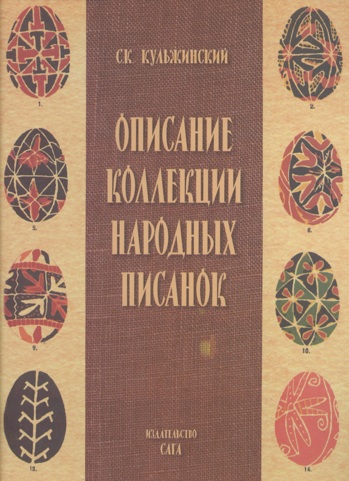
Описание Коллекции Народньіх Писанок
Descriptions of a Collection of Folk Pysanky
Author: С.К. Кульжинский (S.K. Kulzhynskyi)
Edition: Reprint
Format: Large format hardcover
Pages: 176
Language: Russian
Illustrations: 45 full page plates, 33 in color
Publisher: Saga (Kharkiv, 2010)
Availability: Yes (Ukrainian bookstores)
Acquired: Ukraine, from publisher
ISBN: 978-617-575-001
This book is a reprint of Kul’zhynskyi’s epic tome which was published in 1899, while the Ems Ukase was still in effect. Because Tsar Alexander had banned the use of the Ukrainian language in print, any books published in the Russian-occupied areas of Ukraine could only be published in the Russian language. So with this work, an encyclopedic description of Kateryna Skarzhynska’s collection of pysanky.
Skarzhynska collected pysanky from all of Russian-occupied Ukraine and more distant reaches of the Russian empire; her collection (the remains of which are housed in the Poltava Regional Museum) had 2123 pysanky from 18 different hubernias (governorates, Russian administrative districts) :
-
■Volynia (166),
-
■Kyiv (130),
-
■Podilia (770),
-
■Poltava (359),
-
■Kharkiv (36),
-
■Kherson (91),
-
■Chernihiv (75),
-
■Bessarabia (30),
-
■Warsaw (18),
-
■Lublin (25),
-
■Minsk (1),
-
■Hrodnensk(120),
-
■Voronezh (7),
-
■Kuban (12),
-
■Kursk (127),
-
■Oreburg (8),
-
■Ufa (4),
-
■Samara.
The plates depict 2113 pysanky, 521 with full color watercolors, and all of them with tiny black and white drawings.
This is an example of the black and white plates; there are 144 pysanky on each plate/table.

Each pysanky is described in the tex, with name (if known), provenance, place of origin, and a description of the colors.

The color plates reproduce the pysanky in watercolors; all these pysanky are also in the black and white tables; there is a table which links the two.

This is a seminal text in the history of pysankarstvo; if you cannot find a print copy, you can download a pdf here.
Sоme of these pysanky still exist, and are in the collection of the regional museum of Poltava (Museum of Local Lore). The watercolors that were the basis of this book (and a planned second edition which was never printed) were spirited out of the Soviet Union during WWII, and given over to the Ukrainian Orthodox Church of North America. They currently reside in the archives of the Ukrainian Historical and Education Center of New Jersey (Bound Brook). Plans are underway to recreate all the pysanky depicted on the cards and to display both in the future museum building (now under construction).
Back to MAIN Писанка Books home page.
Back to MAIN Books home page.
Back to Pysanka Bibliography.
Search my site with Google




